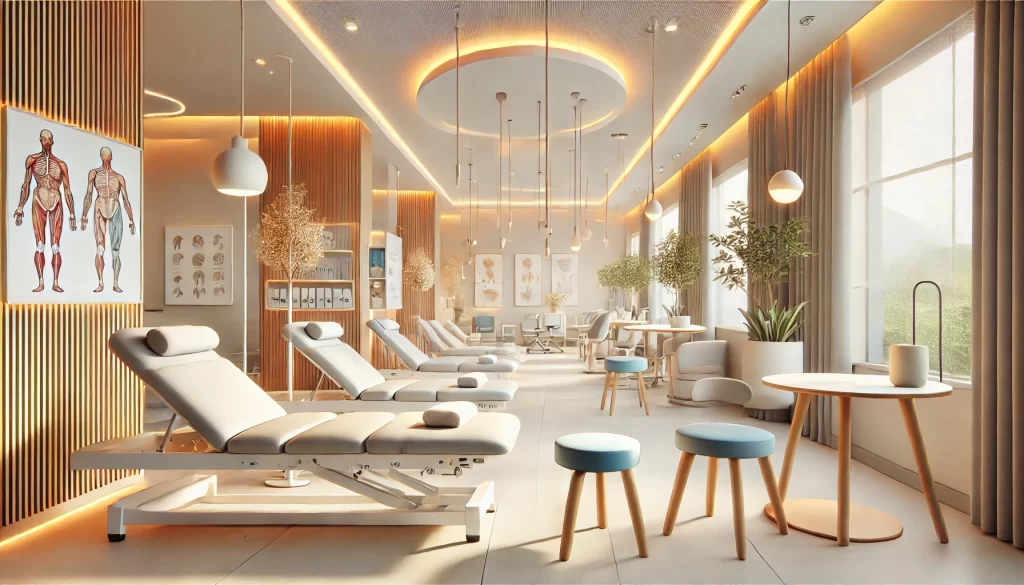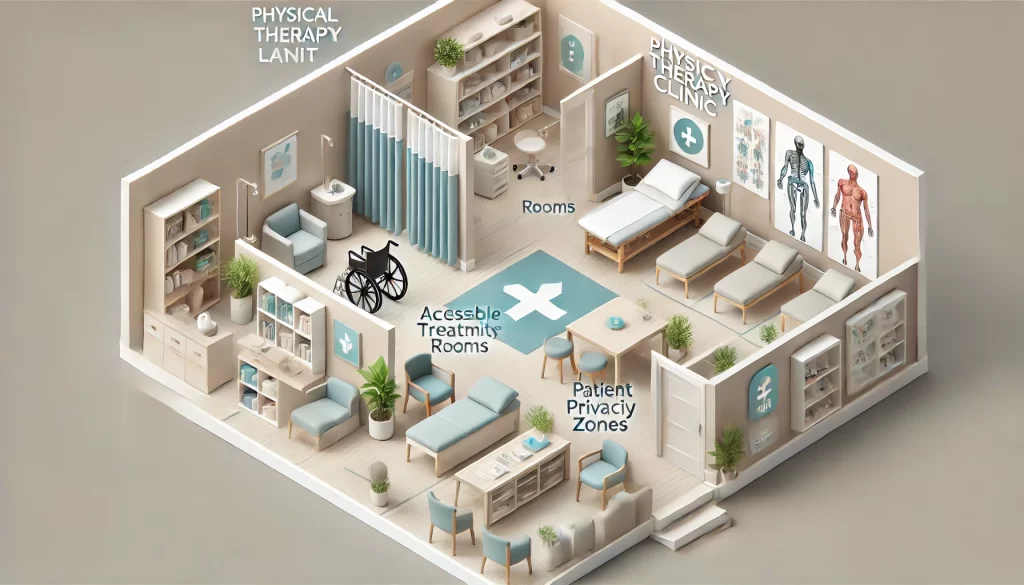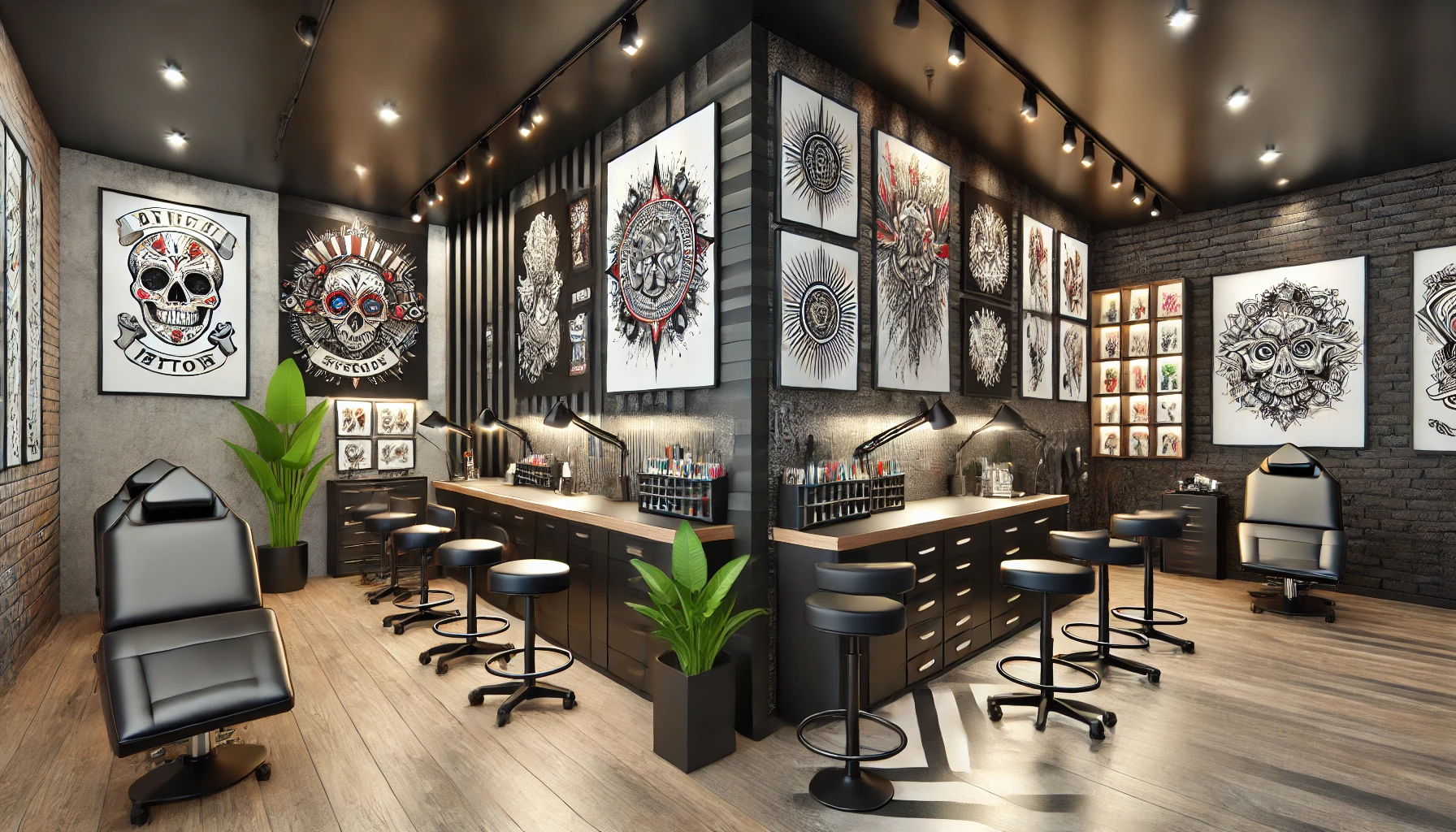Unique Design Needs for Tattoo Shops and Clinics
When designing specialized spaces like tattoo shops and physical therapy clinics, there is a delicate balance between functionality, comfort, and aesthetics. Both types of spaces need to serve very specific purposes, and the interior design must cater to these needs while creating a welcoming atmosphere for clients. From private zones in physical therapy clinics to the creative ambiance in tattoo studios, every aspect of the design plays a vital role in providing both comfort and efficiency.
This blog explores the key interior design considerations for tattoo shops and physical therapy clinics, offering expert insights on how to create spaces that foster both functionality and a positive client experience.

Tattoo Shop Interior Design Considerations
Tattoo shops are not just places where clients come to get tattoos they are immersive environments where creativity, hygiene, and comfort must coexist. The design of a tattoo shop plays a significant role in shaping a client’s experience, from the moment they walk in the door to the time they leave with their new tattoo.
Creating a Welcoming Reception Area
The reception area of a tattoo shop is often the first impression clients will get of your business. This space should be clean, organized, and welcoming. While it doesn’t need to be overly elaborate, the reception should reflect the shop’s personality and atmosphere. Comfortable seating, effective lighting, and clear signage can all contribute to a positive first impression.
When designing the reception area, consider a design that speaks to your brand while also providing a place for clients to feel comfortable while waiting. Incorporating artwork or posters of past tattoos can help create an artistic environment and set the tone for the client’s experience.
Workstations and Tattooing Areas
Tattooing workstations should be designed with both function and hygiene in mind. The layout must be spacious enough to allow for easy movement and access to necessary tools while maintaining a sterile environment. Each station should have sufficient lighting to ensure precision during tattooing, as well as plenty of storage for equipment and supplies.
The design of tattoo workstations should ensure privacy for clients, especially in multi-chair setups. Strategic placement of partitions or dividers can create individual tattooing zones, ensuring that each client feels comfortable and protected.
Privacy and Comfort Zones
Privacy is critical in a tattoo shop, and the interior design should reflect this by ensuring that clients feel at ease during the tattooing process. For larger shops, consider creating private rooms or secluded booths for clients who prefer a more intimate experience.
Additionally, it’s essential to have comfortable seating and a relaxing environment, as many tattoo sessions can last for several hours. Think about adding comfortable chairs, temperature control, and soothing lighting to make the experience as comfortable as possible for clients.
Suggested Posts:
- How to Build a Strong Portfolio to AttracSuggested Posts:
- Top Resources for Interior Design Inspiration
- Importance of Web Presence for Interior Designers
- Best Practices for Website Interior Design Business Goals
Aesthetic and Branding
A tattoo shop’s interior design should reflect its unique personality and artistic vibe. Whether your shop embraces a bold, modern aesthetic or opts for a more vintage or traditional look, the space should visually communicate the type of tattoos you specialize in. The furniture, décor, and overall layout should align with your shop’s brand and the type of tattoos you offer.
Consider using artwork, custom signage, and unique lighting fixtures to set the tone for the shop. Your interior design can become part of the artistic expression of the work you do.

Physical Therapy Clinic Interior Design Considerations
A physical therapy clinic serves as a space for recovery, healing, and comfort. Designing an interior for a clinic involves not only aesthetics but also functionality, privacy, and accessibility. The design of these specialized spaces plays a key role in helping patients feel at ease during their rehabilitation journey.
Reception and Waiting Areas
Similar to tattoo shops, the reception area of a physical therapy clinic should be welcoming and calming. A clean, organized reception desk with comfortable seating is essential. The design should also incorporate clear signage, so patients feel informed about where to go upon arrival.
Soft lighting, soothing colors, and comfortable furnishings can make the waiting area a more relaxing place for patients. Creating a space that feels welcoming will help patients feel more at ease as they wait for their appointments.
Treatment Rooms and Workstations
In a physical therapy clinic, the design of treatment rooms is crucial for providing an effective therapeutic environment. Rooms should be spacious enough for therapists to move freely while using various equipment, such as treatment tables, exercise machines, and mobility aids. Easy access to equipment storage is essential for functionality.
Each treatment area should have sufficient natural light and adjustable artificial lighting to provide the right ambiance. Patients should feel comfortable during their sessions, and the therapist should be able to work efficiently and comfortably.
Suggested Posts:
- Top Resources for Interior Design Inspiration
- Importance of Web Presence for Interior Designers
- Best Practices for Website Interior Design Business Goals
Functional Layout and Accessibility
An effective layout is essential to the smooth operation of a physical therapy clinic. The space should flow efficiently, allowing staff to move between treatment rooms easily while providing a sense of privacy for patients.
Incorporating accessibility features is important for patients with mobility challenges. This includes wide doors, ramps, handrails, and easily accessible restrooms. The design should cater to patients of all abilities, ensuring that everyone feels comfortable in the space.
Privacy Zones
Privacy is especially important in a physical therapy clinic, where patients may feel vulnerable during certain treatments. Private areas or curtained-off zones can be used to create a sense of privacy while still ensuring that the overall design remains functional and open. Patients should feel that they have the space and comfort to recover without feeling exposed.
Balancing Aesthetics and Functionality in Specialized Spaces
When designing tattoo shops and physical therapy clinics, balancing aesthetics and functionality is key. Both spaces need to provide an environment that fosters creativity, relaxation, or recovery, while still serving their specific operational needs.
Creating Functional Layouts for Efficiency
A functional layout ensures that your space is optimized for ease of use and accessibility. For tattoo shops, the layout should allow for efficient movement between workstations and storage areas, while also providing privacy for each client. In physical therapy clinics, the layout should ensure that therapists can easily access necessary equipment while maintaining patient comfort and privacy.
Using Specialized Furnishings
The right furnishings are essential in both tattoo shops and physical therapy clinics. In tattoo shops, furniture should be comfortable, durable, and easy to clean, as well as aesthetically aligned with the shop’s vibe. In physical therapy clinics, specialized furnishings such as adjustable tables, ergonomic chairs, and mobility equipment are necessary to ensure both patient comfort and therapist efficiency.
Incorporating Design Trends
Incorporating current design trends can elevate the space and provide a more engaging environment for clients and patients. However, it’s important that these trends align with the purpose of the space. For example, modern, minimalist design can work well in both tattoo shops and clinics, providing a clean and professional look while keeping the focus on the experience rather than the décor.
Key Takeaways
- Interior design plays a crucial role in creating functional and comfortable spaces in tattoo shops and physical therapy clinics.
- For tattoo shops, consider privacy zones, welcoming reception areas, and aesthetic branding elements to enhance the client experience.
- For physical therapy clinics, prioritize accessibility, functionality, and a calming environment to support the rehabilitation process.
- Balancing aesthetics and functionality ensures both spaces are visually appealing and operationally efficient, enhancing both customer satisfaction and business growth.
FAQs
What are the key design considerations for a tattoo shop?
Tattoo shop design should focus on privacy, comfortable workstations, an inviting reception area, and aesthetic elements that reflect the shop’s style.
How can I design a physical therapy clinic that prioritizes patient comfort?
A physical therapy clinic should have functional treatment rooms, accessible layouts, private zones, and soothing décor to help patients feel comfortable during their recovery process.
What role does the layout play in a specialized space like a tattoo shop or clinic?
The layout ensures efficiency and accessibility. It allows clients and patients to feel comfortable while ensuring staff can work efficiently and effectively.
